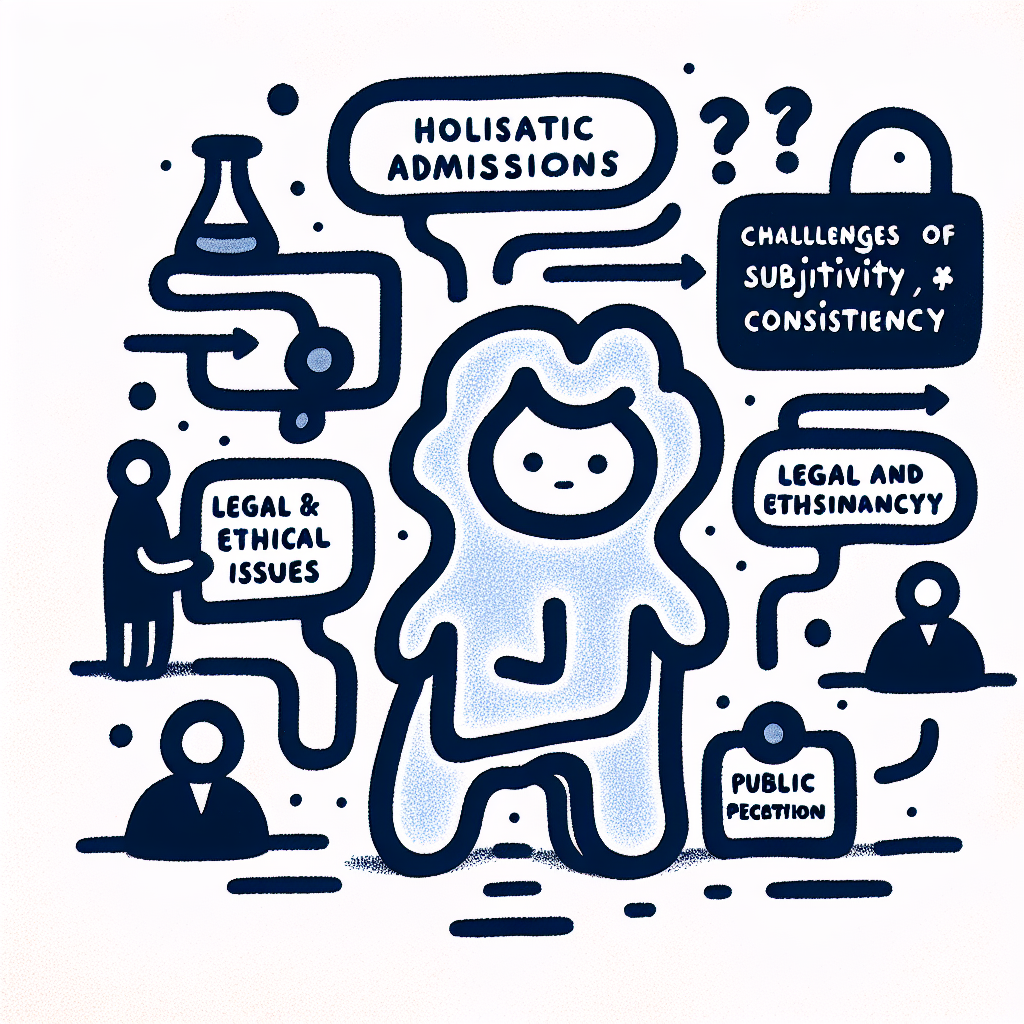Introduction to Holistic Admissions
What is Holistic Admissions?
Holistic admissions explained simply means looking beyond grades and test scores. Instead of focusing solely on academic metrics like GPA and standardized test results, admissions committees consider a wide range of factors. These include an applicant's personal background, extracurricular involvement, leadership experience, community service, essays, recommendation letters, and demonstrated resilience or character. The goal is to evaluate the applicant as a whole person, acknowledging that potential and capability can manifest in many forms.
Why It Matters
Holistic admissions align with institutional goals of diversity, equity, and inclusion. By considering a broader set of attributes, colleges and universities aim to build student bodies that reflect a variety of perspectives and life experiences. This approach helps identify students who may excel in collaborative, innovative, and socially engaged environments, even if their academic metrics are not the highest. Holistic admissions explained in this context show how institutions seek students best positioned for success both in and beyond the classroom.

Core Components of Holistic Admissions
Holistic admissions explained involves evaluating applicants based on a broad range of factors beyond grades and test scores. These components help admissions officers understand the full context of an applicant’s background and potential.
Academic Achievement
Academic measures remain important in holistic admissions. These include GPA, standardized test scores (if submitted), and the rigor of courses taken. However, these metrics are assessed within the context of the applicant’s educational and personal background. For example, a strong GPA in a school with limited advanced coursework may be viewed differently than the same GPA in a school with abundant academic opportunities.
Personal Characteristics
Holistic admissions explained also includes careful consideration of personal traits. Attributes like leadership, resilience, integrity, motivation, and empathy are important indicators of a student’s potential contribution to the campus community. These characteristics are typically revealed through application essays, interviews, and letters of recommendation.
Experiences and Extracurriculars
Admissions committees look at how applicants spend their time outside the classroom. Involvement in volunteering, work, research, athletics, or creative pursuits can show engagement, dedication, and the ability to manage multiple responsibilities. These experiences offer insight into the applicant’s passions and real-world impact.
Alignment with Institutional Mission
A key part of holistic admissions explained is determining whether an applicant’s goals and values align with those of the institution. Schools often seek students who will thrive within their specific culture and contribute meaningfully to their academic and social communities.
Contextual Considerations
Holistic admissions also takes into account the applicant’s background. This includes socioeconomic status, geographic location, access to educational resources, and personal hardships. Understanding these factors helps admissions officers fairly evaluate each applicant’s achievements and potential within their unique context.

Institutional Approaches & Case Studies
University of Massachusetts Amherst
The University of Massachusetts Amherst illustrates how holistic admissions explained in practice leads to a more inclusive evaluation process. The institution emphasizes assessing the full experience and potential of applicants, rather than relying solely on numerical indicators. This approach supports diversity and engagement by using a non-formulaic process that values each individual’s background and capabilities. Promotes inclusion and engagement.
CUNY School of Medicine
At the CUNY School of Medicine, holistic admissions explained means reviewing a range of applicant materials, including academic achievements, personal statements, and evidence of professional preparation. The school explicitly excludes race, gender, religion, and ethnicity as selection factors, focusing instead on mission-fit and a demonstrated commitment to underserved communities. Excludes race, gender, religion, and ethnicity as selection factors.
Yale University
Yale University offers an example of how holistic admissions explained can adapt to external challenges. During the COVID-19 pandemic, Yale affirmed the importance of flexibility in evaluating applicants. The university respected students' decisions regarding grading systems and testing cancellations, emphasizing context-sensitive review. Affirms flexibility in evaluation.
USC Chan Division of Occupational Science and Occupational Therapy
The USC Chan Division demonstrates how holistic admissions explained can serve broader social goals. By incorporating a comprehensive review of applicants, the division has shown that this approach can help increase diversity in the healthcare workforce and address long-standing disparities. Demonstrates how holistic admissions.
Stanford University
Stanford University’s admissions process exemplifies holistic admissions explained through its evaluation of applicants as integrated wholes. The university considers intellectual vitality, extracurricular involvement, and personal insight, rather than separating academic and non-academic components. Evaluates applications as integrated wholes.

Goals and Outcomes of Holistic Admissions
Holistic admissions explained involves evaluating applicants using a wide range of criteria beyond grades and test scores. This approach aims to support institutional values and long-term student success through several key goals and outcomes.
Enhancing Diversity and Inclusion
One of the central goals of holistic admissions is to increase diversity within the student body. By considering a broad range of applicant experiences, including socioeconomic background, cultural heritage, and life challenges, institutions can admit students from historically underrepresented groups. This approach contributes to a more inclusive and equitable learning environment.
Predicting Student Success
Holistic admissions explained includes assessing non-cognitive traits such as resilience, leadership, and motivation. These factors often correlate with persistence and achievement throughout college and beyond. By looking beyond traditional academic metrics, admissions officers can identify students with strong potential who may not have had access to the same resources as others.
Encouraging Institutional Mission Alignment
Holistic review helps align admissions decisions with an institution’s mission and values. By evaluating how applicants might contribute to campus life, community engagement, or academic programs, schools admit students who are likely to thrive and embody the institution’s goals.
Mitigating Bias and Structural Inequity
Traditional admissions practices can favor students with greater access to preparatory resources. Holistic admissions explained highlights how broader evaluation criteria can reduce these disparities. By considering the context of an applicant’s achievements, the process helps level the playing field and counterbalance systemic inequities.

Challenges and Controversies
Holistic admissions explained often sparks debates due to inherent challenges and controversies in its implementation. While the approach aims to evaluate applicants beyond test scores and GPAs, it also introduces complexities that institutions must navigate carefully.
Subjectivity and Consistency
One major challenge is the potential for subjectivity in the evaluation process. Without clearly defined rubrics, admissions decisions can vary significantly based on individual committee members' interpretations. This inconsistency can undermine trust in the process. To address this, institutions must invest in ongoing training and calibration for admissions committees to ensure more uniform standards across evaluations.
Legal and Ethical Considerations
Legal and ethical concerns also surround holistic admissions explained. Efforts to promote diversity, equity, and inclusion (DEI) must be balanced with legal restrictions against giving preferential treatment based on race, gender, or religion. In the United States, recent court rulings have put increased scrutiny on how institutions implement these policies. Maintaining transparency in how decisions are made is essential to uphold both legal compliance and public trust.
Public Perception and Misunderstanding
Public perception presents another challenge. Many people misunderstand holistic admissions explained, believing it undermines fairness or meritocracy. This misconception can lead to skepticism and reduced confidence in the admissions process. Institutions must prioritize clear and consistent communication to help applicants and the wider public understand the rationale and criteria behind holistic evaluations.

Best Practices for Implementing Holistic Admissions
Structured Rubrics and Criteria
To ensure fairness and consistency, holistic admissions explained best when institutions develop structured rubrics. These rubrics should outline specific, measurable criteria for evaluating academic achievements, personal characteristics, and extracurricular involvement. A well-defined framework enables reviewers to assess applicants systematically while accounting for both quantitative and qualitative factors.
Reviewer Training
Proper training is essential for admissions officers to apply holistic admissions effectively. Training should focus on recognizing and mitigating implicit bias, understanding the institution's values, and applying evaluation rubrics consistently. When holistic admissions explained in training sessions, reviewers are better equipped to balance academic metrics with broader indicators of potential.
Iterative Review and Calibration
Holistic admissions is not a static process. Institutions should regularly review admissions outcomes to ensure alignment with institutional goals, such as diversity and inclusion. By analyzing trends and seeking feedback, teams can recalibrate their criteria and processes. This iterative approach keeps holistic admissions dynamic and responsive to evolving educational priorities.
Transparency and Communication
A key aspect of holistic admissions explained is maintaining transparency with applicants. Institutions should clearly articulate their admissions philosophy, criteria, and the role of holistic review. When applicants understand how they are being evaluated, it builds trust and encourages more authentic applications.

Future Directions in Holistic Admissions
Incorporating AI and Data Analytics
As institutions seek to improve transparency and reduce bias in their admissions processes, the integration of AI and data analytics is becoming increasingly common. These tools can help support consistency in holistic review by identifying patterns and trends in applicant data. However, human judgment remains essential to ensure that decisions reflect each applicant's unique context and potential. In the evolving landscape of holistic admissions, explained technologies must be used to enhance—not replace—the nuanced understanding of individual experiences.
Emphasis on Equity-Centered Design
Future holistic admissions practices are focusing more intentionally on equity-centered design. This approach treats holistic review not just as a method for evaluating applicants, but as a component of a larger institutional commitment to equity and access. By aligning admissions criteria with mission-driven goals around inclusion, colleges and universities can better assess how applicants have navigated structural inequities. In holistic admissions explained through an equity lens, evaluators are encouraged to consider systemic barriers alongside academic and extracurricular achievements.
Responding to Changing Legal Landscapes
Recent legal developments, including Supreme Court decisions on affirmative action, are prompting institutions to reassess their admissions strategies. In response, holistic admissions are being adapted to comply with new legal standards while preserving a commitment to diversity. This includes shifting focus to race-neutral factors such as socioeconomic background, community context, and life experiences. Holistic admissions explained in the context of legal compliance emphasizes the importance of lawful yet inclusive practices that reflect institutional values and societal needs.

📚 Additional Resources
For those seeking to explore the topic of holistic admissions explained in greater depth, the following resources provide valuable insight into how various institutions implement and advocate for this approach:
- University of Massachusetts Amherst – Holistic Admissions: Offers guidance on implementing holistic admissions practices with a focus on equity and inclusion.
- CUNY School of Medicine – Holistic Admissions Procedure: Details the school's specific steps and considerations when reviewing applicants using a holistic model.
- Yale University – Affirmation of Holistic Admissions: A statement affirming Yale’s continued commitment to holistic admissions explained in the context of recent legal decisions.
- USC Chan Division – Holistic Admissions in Occupational Therapy: Demonstrates how holistic admissions can enhance diversity in professional programs.
- Stanford University – Holistic Admission Overview: Provides an overview of how Stanford integrates academic and personal factors in its admissions process.

Conclusion
Holistic admissions explained: this approach provides a comprehensive way to assess applicants beyond test scores and GPAs. By evaluating the whole individual—academic accomplishments, personal qualities, life context, and goals—institutions can make more informed and inclusive decisions. As colleges and universities navigate changing social expectations and legal frameworks, the holistic model continues to offer a balanced and ethical strategy for building diverse and mission-driven student bodies.














